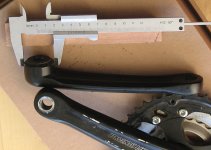happybrahma
10 µW
- Joined
- Oct 29, 2014
- Messages
- 6
Ok, I'll admit my application is not an e-bike. I'm trying to figure out how to freewheel a child stoker on a tandem. This seems to be the best forum I've found for discussing freewheel cranks.
Also, this is for a child stoker (third crank). Trying to freewheel the real stoker on a left side sync, right rear drive tandem is a harder/different problem. The bikemotive left/right freewheel crank looks like it would solve the real stoker problem. If fact, I think that design would allow both the captain and stoker to freewheel independently. Basically, the motor is replaced with the captain. Unfortunately, that design seems to require a very custom bottom bracket, so I won't be attempting to make one of those!
The child stoker It is a simple left side single chainring that needs to be able to spin forward free when not pedaling. This would be a simple left side freewheel crank. As far as I can tell, no such product exits.
So, I'm considering how to make one. I've not used any of these parts before. If I've got this completely botched, please help me out.
1. Get a regular right threaded freewheel crankarm.
2. Get a flange freewheel intended for use as regular right front freewheel.
3. Install the freewheel backwards so that the removal slots are against the crank arm. AFAICT, this will result in the correct freewheeling direction.
4. Use a pedal repair reamer/tap and heliocoil to convert the right side pedal thread to left side pedal thread.
5. Use a strong adhesive to permanently thread the freewheel onto the crank. This is to avoid left side pedaling unscrewing the freewheel from the crank.
6. Get a spider so I can mount my chainring on the freewheel flange.
I'm not sure if I understand all the thread and freewheel directions of these parts directly. I'm also not sure of the best way to bond the freewheel to the crank. I suppose I could disassemble the freewheel, and braze the shell into the crank arm if the metals are similar. I've never seen or taken apart one of these freewheels, so I'm not sure if it would be possible to re-assemble the freewheel with the shell stuck in the crank.
Do I have any of this correct?
Also, I'd rather not use this topic discuss the pros/cons of stoker freewheeling in general, which would be the typical result of posting such a topic on a tandem centric forum
-Steve
Also, this is for a child stoker (third crank). Trying to freewheel the real stoker on a left side sync, right rear drive tandem is a harder/different problem. The bikemotive left/right freewheel crank looks like it would solve the real stoker problem. If fact, I think that design would allow both the captain and stoker to freewheel independently. Basically, the motor is replaced with the captain. Unfortunately, that design seems to require a very custom bottom bracket, so I won't be attempting to make one of those!
The child stoker It is a simple left side single chainring that needs to be able to spin forward free when not pedaling. This would be a simple left side freewheel crank. As far as I can tell, no such product exits.
So, I'm considering how to make one. I've not used any of these parts before. If I've got this completely botched, please help me out.
1. Get a regular right threaded freewheel crankarm.
2. Get a flange freewheel intended for use as regular right front freewheel.
3. Install the freewheel backwards so that the removal slots are against the crank arm. AFAICT, this will result in the correct freewheeling direction.
4. Use a pedal repair reamer/tap and heliocoil to convert the right side pedal thread to left side pedal thread.
5. Use a strong adhesive to permanently thread the freewheel onto the crank. This is to avoid left side pedaling unscrewing the freewheel from the crank.
6. Get a spider so I can mount my chainring on the freewheel flange.
I'm not sure if I understand all the thread and freewheel directions of these parts directly. I'm also not sure of the best way to bond the freewheel to the crank. I suppose I could disassemble the freewheel, and braze the shell into the crank arm if the metals are similar. I've never seen or taken apart one of these freewheels, so I'm not sure if it would be possible to re-assemble the freewheel with the shell stuck in the crank.
Do I have any of this correct?
Also, I'd rather not use this topic discuss the pros/cons of stoker freewheeling in general, which would be the typical result of posting such a topic on a tandem centric forum
-Steve






